Electrolytes/Batteries
Polymer electrolytes (plus ionic liquids)
Mixtures of polymer electrolytes and ionic liquids
Solid polymer electrolytes have many advantageous properties such as very high energy density and convenient mechanical properties. This qualifies them as possible candidates for electrolytes in, e.g., lithium-ion batteries. Unfortunately, solid polymer electrolytes show poor ionic conductivity at room temperature. This problem has been overcome by adding room temperature ionic liquids ILs. Over the years molecular dynamics studies help to understand microscopic dynamics and provide many crucial insights about such systems.
We investigate ion transport mechanisms, their associations and its effect on ionic conductivity via molecular dynamics simulations. So far our analysis is focused on PEO/Li-TFSI/MPPY-TFSI systems. With state of the art force fields experimentally known structures and dynamical quantities (e.g. diffusion coefficients) can be reproduced satisfactorily.
Some key results:
© ah 1. Since a Li-cation is coordinated with the polymer host, its transport properties are intimately connected with the polymer dynamics. We have identified three key Li transport mechanisms associated with distinct time scales: (i) intrachain motion along a chain (time scale τ1); (ii) polymer-segment motion translating the cation together with the polymer chain (time scale τ2, basically corresponding to the Rouse time); (iii) interchain hopping from one chain to another (time scale τ3). The resulting transport model can be solved analytically, reproducing simulation as well as experimental results.
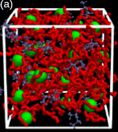
© ah 2. ILs enhance the Li-diffusion by increasing the segment mobility of the host chain, that is, τ2 becomes shorter with higher IL-concentration. The key contribution of ILs is to prevent polymer crystallisation that results in high ionic conductivity at room temperature.
Ionic liquids
Mixture of ionic liquids and lithium salts
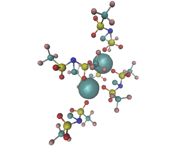
© ah Ionic liquids are a new class of materials. They have very promising properties for many applications, but only a few ionic liquids are well characterized until now. Despite the macroscopic characterization like diffusion coefficients, the microscopic properties are still not well unterstood. The advantages of this class include properties like low melting points, no significant vapor pressure and high dissolution power because of their electric charge.
In a collaboration with Stefano Passerini (KIT) and Oleg Borodin (U. S. Army Research Laboratory) we investigate via experimental and simulation techniques the transport properties of ionic liquids doped with lithium salts. As ionic liquids we use two different cations N-ethyl-N-methyl-imidazolium (emim) and lithium ions and two kinds of anions, namely bis(fluoro-sulfonyl)-imide (FSI) and bis(trifluoromethane-sulfonyl)-imide (TFSI). We are interested in different compositions of the anions and the influence on transport properties.
In collaboration with Dmitry Bedrov (University of Utah) we investigate the influence of different cations on lithium ion coordination and transport properties. For our analysis we choose one cation based on emim and one based on pyrrolidinium (N-methyl-N-propylimidazolium (pyr13)).Properties close to electrode interfaces
We investigate the molecular transport and reaction processes at the interface between electrode and electrolyte in lithium ion batteries using a combination of molecular dynamics (MD) and Monte-Carlo (MC) simulations. More specifically, we are interested in the microscopic mechanisms which lead to the initial formation of the Solid Electrolyte Interphase (SEI) and the formation of dendrites in lithium ion batteries.
Two complementary methodical approaches are pursued within our group. On the one hand, we are developing a lattice MC battery model that seeks to investigate the impact of molecular-scale parameters, such as charge transport properties, which have been derived from MD simulations, on macroscopic cell characteristics, for example quantified by the output voltage or current.
On the other hand, we are working on incorporating chemical reactivity into classical MD simulations by introducing reactive steps additionally to the MD steps. By doing so, we aim at developing a simulation method that incorporates chemical reactivity in a simple but realistic manner while retaining the time and length scales of standard MD simulations.Disordered materials
Supercooled liquids in (metastable) equilibrium / PEL approach
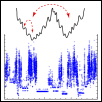
© ah For many years we have studied the dynamics of supercooled liquids. One way of charactering the dynamics is via mapping on the properties of the underlying potential energy landscape (PEL). In this framework the complex dynamics corresponds to jumps between different minima on the PEL. It turns out that the jump rates are strongly related to the potential energy of the corresponding minimum. Furthermore, by introducing some coarse graining procedure one can define sets of minima (metabasins) such that the dynamics between metabasins can be described as a simple random-walk. In this framework many important questions can be answered. What is the reason for the dramatic slowing down of glass-forming liquids? Why is silica a strong glass-forming system, i.e. shows simple Arrhenius-behavior? What is the reason why the viscosity and the diffusivity are decoupled for many glass-forming systems? What determines the emergence of slow and fast regions, i.e. the presence of dynamic heterogeneities? How do adjacent regions in the supercooled liquid communicate with each other? Within this approach we aim to obtain a far-reaching understanding of the very nature of the glass transition.
Rheology of supercooled systems and glasses
Applying a shear strain to a supercooled liquid or a glassy system shows interesting non-linear properties: Changes of the viscosity (e.g. shear thinning) as well as aging or rejuvenation. For this purpose we implement Lees-Edwards boundary conditions.
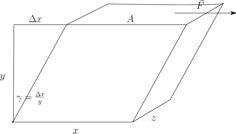
© ah Our focus lies in the description of these phenomena within the Potential Energy Landscape (PEL) framework. We therefore perform molecular dynamics simulations on small systems with our own simulation software written in C++, which enables us to use a special minimization algorithm to quickly gather information about the inherent structures (IS) the system visits. From this data we extract statistical properties and try to make a statistical model describing the observed macro-rheological behaviour. Of key interest in this description is the role of metabasins. To describe macroscopic systems, we also investigate the influence of finite size effects and the coupling of small systems to form a larger system.
Membranes/Biomolecules
Lipid membranes
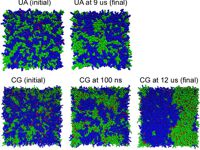
© ah Rafts that are formed as a result of cooperation of saturated lipids with cholesterol or of saturated lipids with proteins or peptides are suggested to participate in various functions of the cell. The methods of MD simulations can provide important information on the driving forces of raft formation and properties of lipid phases. Comparison of the MARTINI coarse-grained (CG) bilayer system with an equivalent atomistic system (UA) comprised of DPPC, unsaturated dilinoleyl phosphatidylcholine (DUPC) lipids and cholesterol (CHOL) shows a very similar behavior concerning the nature of the phase separation.
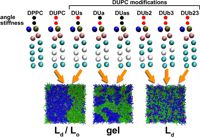
© ah We systematically vary the properties of CG lipids and CHOL to study the molecular requirements for the raft formation. It turns out that the unmixing is largely driven by van der Waals interactions between DPPC - CHOL/DPPC pairs and is nearly independent of the entropy of the DUPC chains. Furthermore by substituting the CHOL with shorter and stiffer DPPC-like molecules one observes unmixing similar to DPPC/DUPC/CHOL system which suggests the rigid and flat structure of CHOL to play a key role in raft formation.
We also put major efforts into the mapping of microscopically described mixtures of lipids and proteins onto 2D lattice models. A key question deals with the minimum number of the degrees of freedom to semi-quantitatively reproduce the microscopic system. In this way we aim to simulate complex mixtures of lipids and proteins in the near future.Interaction of proteins and lipid membranes
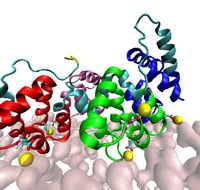
© ah With help of the HPC resources of the University of Muenster (PALMA) we actively investigate the properties of binding of certain surface proteins to a bilayer surface mediated by calcium ions where such protein-membrane interactions may induce raft formations. Jointly with experimental groups we investigate the interaction of lipids with proteins of the Annexin family.
Protein-protein interaction
In collaboration with the group of Prof Mootz we investigate properties of the SIM/SUMO protein ligand complexes. The associaton of different SIM peptide chains and the SUMO protein oligomers plays a central role in posttranslational modification of proteins. We employ atomistic molecular dynamics simulations to understand the structure and dynamics of these complexes. Furthermore we use enhanced sampling methods to calculate the binding free energy of the these complexes.
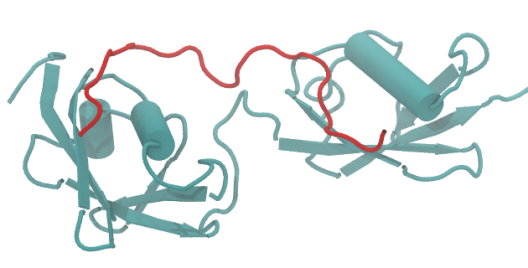
© ak The image shows a diSUMO (turquoise) protein in complex with a two SIM containing peptide chain (red). For example we want to find out what impact the complexation has on the dynamics of the SUMO subunits of the diSUMO relative to each other and what favorite conformation the SIM peptide chain adopts in the complex.
Structure formation on surfaces
Lipophilic molecules
Structure formation of lipophilic molecules on surfaces
Thin film deposition process is evolving continuously due to its huge technological importance in the field of organic field effect transistors (OFET), organic thin film transistors (OTFT), light emitting diodes (LED) etc. where different organic materials with conjugated π- orbitals are used as adsorbates. The efficiency of these nanoscale molecular devices depends on the molecular structure. In this project we investigate the influence of deposition rate and substrate temperature on the structure formation of substituted adenine nucleobases (lipophilic molecules). Experimentally, the emergence of two phases is observed (interdigitated and lamellar phase).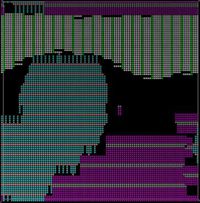
© ah Via appropriately devised lattice models this behavior can be reproduced and the non-equilibrium principles behind these observations can be clarified.
2D silica systems
Understanding the properties of two-dimensional silica systems
A new honeycomb like stable allotrope of silica has been recently prepared experimentally on Ru and graphene support. These experimental results have major impact in the field of semiconductors but serve as a very interesting model system to study supercooled liquids and glasses. It is a bi-layer structure with a hexagonal framework of Silicon-Oxygen bonds in each layer. Depending on preparation condition and cooling rates it is possible to generate crystalline and amorphous structures and sometimes both in the same layer; making it the world's thinnest glass former. A mysterious symmetry between upper and lower layer is present in both the crystal and amorphous form. Due to its two-dimensional nature, it is possible to map the position of the atoms in real space with STM or SPM methods. The ring statistics in amorphous phase has remarkable similarity with Zacharisen's prediction of glass structure of silica.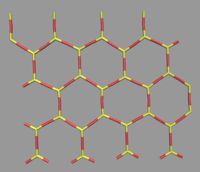
© ah We have developed a 2D silica type force-field that has the ability to generate the structural properties of two-dimensional silica. With the aid of molecular dynamics simulation, we are studying the structural and dynamic properties of this model at different conditions. We also plan to study how the various properties of bilayer silica depend, e.g., on the addition of metal ions.
Formation of designed patterns
Particles on close-by stripes
Concepts in simulation methodology and free energy calculations
Markov state modelling
Wang-Landau optimization
Soft matter assembly
Micelle formation
Frame-guided assembly of micelles and vesicles
The formation of self assembled structures such as micelles has been intensively study and is well understood. Recent studies use a new approach of vesicle formation by starting with a molecular frame (based, e.g., on DNA) which serves as a basis for new micelles/vesicles. In this project we develop a simple but powerful model for amphiphilic molecules and study the thermodynamcis and kinetics of micelle formation via stochastic simulations. The insights we acquire will then be applied to coarse grained MARTINI simulations of real systems.
Agglomeration properties of Janus particles
Sports statistics
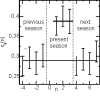
© ah Seit einigen Jahren untersuchen wir als „Hobby-Projekt“ die Fußball-Bundesliga unter verschiedenen statistischen Aspekten. Dabei kommen Analysetechniken zum Einsatz, die auch für die Beschreibung physikalischer Systeme benutzt werden.
Verschiedenste Fragen werden untersucht:
- Gibt es Serien?
- Gibt es heimstarke Mannschaften?
- Was ist eine möglichst sinnvolle Definition der Leistungsstärke einer Mannschaft?
- Wie wichtig ist die Abwehr im Vergleich zum Sturm?
- Wie verändert sich die Leistungsstärke einer Mannschaft im Laufe der Saison bzw. zwischen verschiedenen Jahren?
- Wie groß sind die Zufallsbeiträge beim Fußballspiel?
- Welche psychologischen Effekte gibt es innerhalb eines Fußballspiels?
- Wie ergibt sich aus der Leistungsstärke zweier Teams der mittlere Ausgang des Spiels?
- Sind Trainerwechsel sinnvoll?
- Welche zusätzlichen Informationen bieten die Marktwertabschätzungen für die Leistungsfähigkeit?
- Wie sinnvoll ist die Notengebung durch Sportreporter?
- ...
Das Verständnis vieler dieser Mechanismen erlaubte uns, ein Modell der Fußball-Bundesliga zu entwerfen, welches auf statistisch optimale Weise die Leistungsfähigkeiten der Mannschaften sowie die Saisonprognose bestimmt.Wieso beschäftigen sich Physiker mit Fussball?
Darauf gibt es eine ganz einfache Antwort: Weil Physiker auch Fußballfans sind! Weil sie auch jeden Samstag mit ``ihrer'' Mannschaft mitfiebern und sich genauso über Siege freuen und über Niederlagen geknickt sind wie jeder andere Fan.
Andererseits beschäftigen wir uns in unserer Arbeit mit der statistischen Analyse von Daten. Was liegt also näher, als die Daten von allen Fußballspielen der Bundesliga zu nehmen und sie mit unseren Methoden auszuwerten? Vielleicht kommt ja etwas Interessantes dabei heraus?
Das ist übrigens nicht neu. Solche Auswertungen werden von Physikern und Statistikern schon seit Jahrzehnten gemacht. Die Berechnungen der Oddsetquoten basiert z.B. auf solchen Methoden. Und bestimmt kennen Sie die vielen Fußballstatistiken, mit denen man ständig überschüttet wird:
Wieviele Minuten ein Stürmer jetzt schon ohne Torschuß ist, wie häufig eine Mannschaft in dieser Saison auswärts gewonnen hat, wieviel Prozent der Zeit Mannschaft A im Ballbesitz war und wieviel Mannschaft B u.s.w.
Sie sehen, Statistiken sind auch im Fußball überall.
Statistik ist übrigens die Wissenschaft vom Zufall. Und die ist auch nicht neu. Seit über 200 Jahren beschäftigen sich Wissenschaftler damit, darunter so berühmte Männer wie Carl Friedrich Gauss oder Leonhard Euler, obwohl die mit Fußball nicht unbedingt etwas zu tun hatten.Was hat Fussball mit Zufall zu tun?
Natürlich gibt es starke und schwache Mannschaften. Und natürlich gewinnt im Allgemeinen die stärkere Mannschaft ein Spiel und steht am Ende der Saison weiter oben in der Tabelle als eine schwächere. Aber wir wissen alle, dass das leider nicht immer so ist:
"Wenn der Schiedsrichter den Handelfmeter gegeben hätte, wäre Cottbus 2:0 in Führung gegangen und Stuttgart vielleicht doch nicht Meister geworden." "Wenn Petric den Freistoß nicht an die Latte gesemmelt hätte, sondern 2 cm darunter, hätte Dortmund ausgeglichen und das Spiel wäre vielleicht ganz anders verlaufen."
Manchmal entscheidet also der Zufall ein Spiel oder sogar über den Tabellenstand. Aber wieviel Zufall ist drin im Fußball? Kann man sagen: Soundsoviel Prozent ist Glück und soundsoviel Prozent ist Können?
Das sind genau die Fragen, die uns Physiker interessieren, und wir haben auch die Möglichkeiten darauf Antworten zu geben.Wie funktioniert eigentlich so eine Datenanalyse?
Zunächst benötigt man Material, das man analysieren will. Wir haben dazu die Ergebnisse der letzten 41 Saisons der 1. Bundesliga genommen. (Wir beginnen 65/66, weil ab da 18 Mannschaften gespielt haben und lassen 91/92 weg, weil in dieser Saison 20 Mannschaften in der BL waren).
Dann machen wir ganz einfache Untersuchungen:
Wieviele Tore gibt es im Durchschnitt pro Spiel? Antwort: 3,1
(Das hat sich übrigens geändert. Während der letzten 20 Jahre waren es nur noch 2,8)
Wieviele Tore schießt eine Mannschaft im Durchschnitt zu Hause? Antwort: etwa 1,9
... und auswärts? Antwort: etwa 1,2
Und schon haben wir ein erstes Ergebnis: Die Mannschaften sind zu Hause stärker als auswärts. "Gut," werden Sie jetzt sagen,"das habe ich vorher auch schon gewusst." Aber hätten Sie auch gewusst, dass die Mannschaften im Schnitt zu Hause 0,7 Tore pro Spiel mehr schießen, als auswärts? Sie sehen also, unsere Ergebnisse liefern in diesem Fall nicht nur die Bestätigung, dass etwas so ist, wie man es erwartet, sondern sie liefern auch gleich eine Angabe wie groß ein Effekt ungefähr ist.
Natürlich führen wir auch andere Auswertungen durch. Die sind aber so kompliziert, dass wir Sie mit der Mathematik, die dahintersteckt, nicht langweilen wollen. Wichtig ist, was dabei rauskommt.
Eine kleine Randbemerkung sei hier gestattet:
Sie merken schon, dass wir häufig die Worte ungefähr und etwa benutzen. Das liegt im Wesen der Statistik. Wir können immer nur sagen, dass ein Ergebnis mit einer gewissen Wahrscheinlichkeit richtig ist. Das heißt aber nicht, das solche Aussagen unnütz sind, es heißt nur, das es eventuell auch anders sein könnte. Das ist wie mit dem Wetter: Wenn ein Meteorologe für den nächsten Tag eine Regenwahrscheinlichkeit von 90% voraussagt, kann es morgen auch trocken bleiben. Es wäre aber trotzdem unklug, ohne Regenschirm aus dem Haus zu gehen.Und was kommt dabei heraus?
Wir haben viele schöne Ergebnisse erhalten, aber die beiden interessantesten betreffen zwei sogenannte Fußballmythen. Nämlich die Existenz von heim- oder auswärtsstarken Mannschaften und die Existenz von Serien.
Heim- und Auswärtsstärke
Dazu haben wir die Tordifferenz der Auswärtsspiele und die Tordifferenz der Heimspiele aller Mannschaften der letzten 40 Jahre gesondert untersucht. Das Ergebnis hat uns selbst überrascht: Es gibt keinen Hinweis darauf, dass Mannschaften besonders häufig auswärts oder zu Hause gewonnen hätten. Was nicht heißt, dass manche Mannschaften nicht häufiger einmal auswärts gewonnen hätten, aber das ist alles noch im Rahmen der erwarteten Schwankungen.
Das ist wie mit den Lottozahlen: Wir können sicher darauf vertrauen, dass alle Zahlen gleich wahrscheinlich gezogen werden. Trotzdem wurde in 2735 Ziehungen die 13 nur 272 Mal, die 49 aber 386 Mal gezogen. Das ist eben Statistik und man darf daraus nicht schließen, dass die 13 oder die 49 etwas Besonderes sind.
Serien
Hierfür haben wir uns angesehen, ob eine Mannschaft, die 2, bzw. 4 Mal hintereinander gewonnen oder verloren hat, danach besonders gut oder besonders schlecht spielt.
Und das Ergebnis: Nach 2 Spielen kann man noch keinen Effekt erkennen, aber nach 4 verlorenen Spielen ist die Tendenz weiterhin schlecht zu spielen deutlich ausgeprägt. Das Gleiche gilt auch für Mannschaften, die 4 mal hintereinander gewonnen haben. Wer also 4 Mal hintereinander verliert oder gewinnt, spielt schlechter als es seiner eigentlichen Stärke entspricht. Ob das nun fehlendes Selbstvertrauen oder Übermut ist, wissen wir nicht, aber interessant ist es trotzdem.Wozu ist das alles gut?
Wie gesagt, unsere Aussagen sind immer mit einem Fehler behaftet. Aber das Wichtige ist, dass wir diesen Fehler auch bestimmen können. Wir können also sagen, wenn es einen Effekt der Heimstärke gibt, so ist er so schwach ausgeprägt, dass er keine Rolle spielt.
Hilft das einer Mannschaft? Wir wissen es nicht. Dafür gibt es andere Spezialisten, die für die Umsetzung unserer Erkenntnisse zuständig sind. Da wollen wir uns auch gar nicht einmischen. Ein guter Trainer weiß selbst am besten, wie er seine Mannschaft führen muss. Er weiß auch, dass seine Jungs (und Mädels) nach ein paar Siegen in Folge dazu neigen, leichtsinnig zu werden und wie er sie motivieren kann, trotzdem mit voller Konzentration zu spielen.
Aber vielleicht nützt es ihm, vor dem Spiel gegen eine vermeintlich auswärtsstarke Mannschaft sagen zu können:"Hört mal Jungs: Da haben ein paar Leute, die was davon verstehen, herausgefunden, dass es sowas wie Auswärtsstärke gar nicht gibt. Die anderen hatten einfach nur ein paar Mal Glück. Und jetzt geht ihr da raus und beendet ihre Glückssträhne!"
Wer weiß, vielleicht hilft es ja?
In diesem Sinne, spannende Spiele und viele Tore, wünschen Ihnen
Andreas Heuer und Oliver Rubner
Publikationen
D. Riedl, B. Strauss, A. Heuer
Why the three-point rule failed to sufficiently reduce the number of draws in soccer: An application of Prospect Theory
Journal of Sport & Exercise Psychology 37, 316-326 (2015)
D. Riedl, B. Strauss, A. Heuer, O. Rubner
Finale furioso: Referee biased injury times and their effects on home field advantage in soccer
Journal of Sport Sciences (2014)
A. Heuer, O. Rubner
Optimizing the Prediction Process: From Statistical Concepts to the Case Study of Soccer
PLoS ONE 9, e104647 (2014)
A. Heuer, J. Smiatek, B. Strauss, D. Riedl
Informationsgehalt von Fussball-Spieldaten
in „Fußball in Forschung und Lehre - Beiträge und Analysen zum Fußballsport XIX“, M. Lames, O. Kolbinger, M. Siegle, D. Link (Hrsg.), 75-79 (2014)
A. Heuer
Der perfekte Tipp. Statistik des Fußballspiels
Wiley-VCH (2012)
A. Heuer, O. Rubner
How does the past of a soccer match influence its future?
arXiv:1207.4471v1, PLoS ONE 7/11, e17678 (2012)
A. Heuer, C. Müller, O. Rubner, N. Hagemann, B. Strauss
Usefulness of Dismissing and Changing the Coach in Professional Soccer
PLoS ONE 6/3, e17664 (2011)
A. Heuer, C. Müller, O. Rubner
Soccer: Is scoring goals a predictable Poissonian process?
Europhys. Lett 89, 38007 (2010)
A. Heuer, O. Rubner
Fitness, chance, and myths: an objective view on soccer results
Eur. Phys. J. B 67; 445-458 (2009)
Artikel zur Prognose
Spiegel online: "Bundesliga-Prognose: Dortmunds Ballast, Paderborns Chance zur Sensation" (14.03.2015)
Spiegel online: "Bundesliga-Prognose: Düstere Aussichten für Stuttgart und den HSV" (28.03.2014)
Spiegel online: "Wer die Bayern noch stoppen kann" (08.11.2013)
Spiegel online: "Der BVB und das eine Prozent" (05.04.2013)
Spiegel online: "Die Chancen der Bayer-Jäger" (14.12.2012)
Spiegel online: "Warum Augsburg so gut ist wie der FC Bayern" (09.11.2012)
Spiegel online: "Millionen für die Meisterschale" (19.10.2012)
Spiegel online: "Von wegen Bayern-Dusel!" (02.10.2012)
Spiegel online: "Showdown in Dortmund" (23.03.2012)
Spiegel online: "Liebe Bayern, reserviert schon mal den Balkon!" (21.12.2011)
Spiegel online: "Warum Bayern Meister wird - und der HSV nicht absteigt" (30.09.2011)
Spiegel online: "Statistik mit Schmunzelfaktor" (03.06.2011)
Spiegel online: "Trainerwechsel bringen nichts" (11.04.2011)
Spiegel online: "Die Zahlen sprechen für den Bayern-Sieg" (25.02.2011)
Spiegel online: "Nur 13% fehlen Dortmund für den Titel" (17.12.2010)
Spiegel online: "Wie Mainz den Bayern wirklich zusetzt" (29.10.2010)
Ausgewählte Medienberichte
Braunschweiger Zeitung:
"Eintrachts Chance auf den Aufstieg liegt bei 92 Prozent" (02.02.2013) Textbeitrag
"Computer hat errechnet: Eintracht holt 72 Punkte" (02.02.2013) Textbeitrag
Die Welt:
"Warum Ahnungslose beim Tippen abräumen" (18.01.2013) Textbeitrag
Stuttgarter Nachrichten:
"VfB bleibt zu 83 Prozent erstklassig" (19.10.2010) Textbeitrag
Spektrum der Wissenschaft:
"Ist Fussball ein Glücksspiel?" (Juni 2010) Textbeitrag
Die Welt:
"Physik-Professor sagt Weltmeister voraus" (12.06.2010) Textbeitrag
Westfälische Nachrichten:
"WM-Rechenmodell aus Münster: Brasilien holt den Titel" (08.06.2010) Textbeitrag
SPIEGEL ONLINE Wissenschaft:
"Warum Bayer wahrscheinlich Meister wird" (05.02.2010) Textbeitrag
Deutschlandfunk:
"Mythen und Zufälle" (März 2009) Textbeitrag
Physik-Journal 06 / 2008 S. 49:
"'Tore schießen ist wie ein radioaktiver Zerfall'' (Juli 2008) Textbeitrag
Süddeutsche Zeitung:
"Zerstörte Bundesliga-Mythen" (März 2008) Textbeitrag
SPIEGEL ONLINE Wissenschaft:
"Der Fussballgott würfelt" (25.02.2008) Textbeitrag
